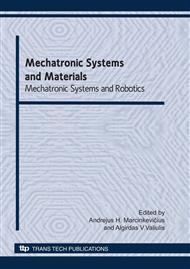p.355
p.360
p.366
p.371
p.377
p.383
p.387
p.392
p.405
Limb/Ground Impacts and Unexpected Impacts Control Strategy for a Model of a Walking Robot Limb
Abstract:
The paper deals with numerical analysis of dynamics of walking robots. The focus is on limb/ground contact. Normal and tangent direction are considered separately. In the normal one, the contacts are modeled as unilateral constraints. In the tangent one, slip and friction are considered. As the contacts are unilateral, nonzero velocities could be present before the contact. These velocities diminish rapidly, and significant contact forces are present. The forces have destructive influence on the robot structure, and the impulsive changes of the arms velocities can disorient the control system. In the paper, the impact consequences are discussed, as well as consequences of installation of a 0/1 contact sensor. A 3D mechatronic multibody model of a quote of a robot is considered. Its limb is driven by DC motors and controlled by a dedicated control system. With the zero signals from the sensor, the control prevents a constant velocity of the limb end. The normal component of the velocity has to be stopped at the positive signals, and the motor current has to be reduced. Exemplary calculations are presented in the paper.
Info:
Periodical:
Pages:
377-382
Citation:
Online since:
June 2010
Authors:
Price:
Сopyright:
© 2010 Trans Tech Publications Ltd. All Rights Reserved
Share:
Citation:


